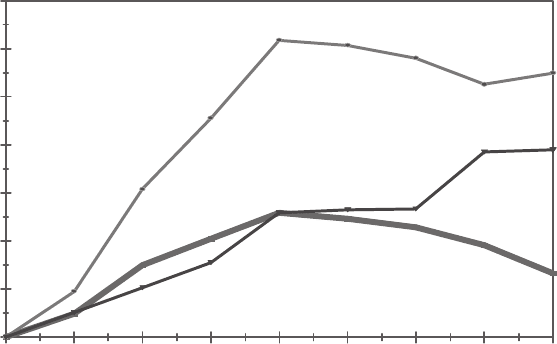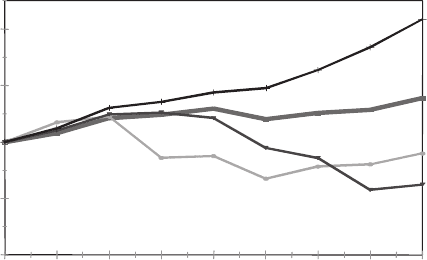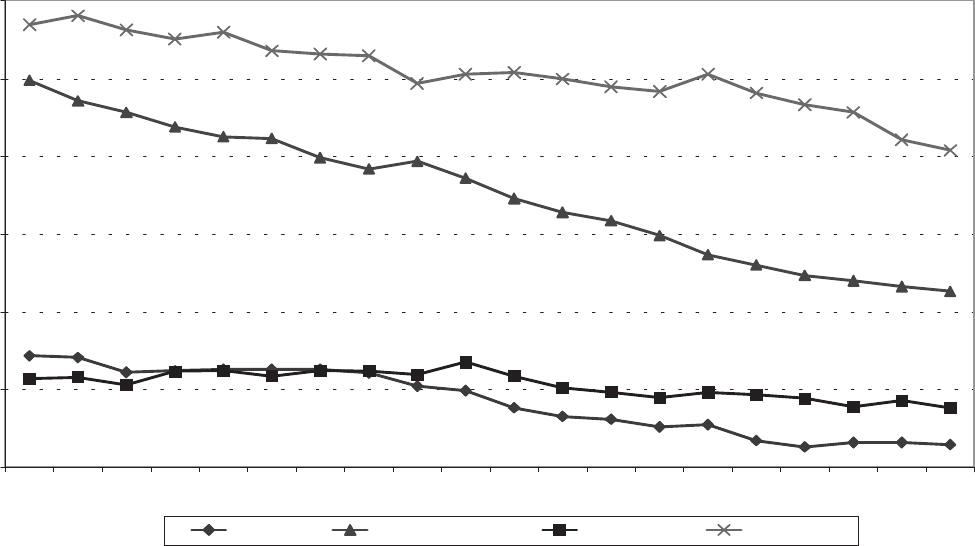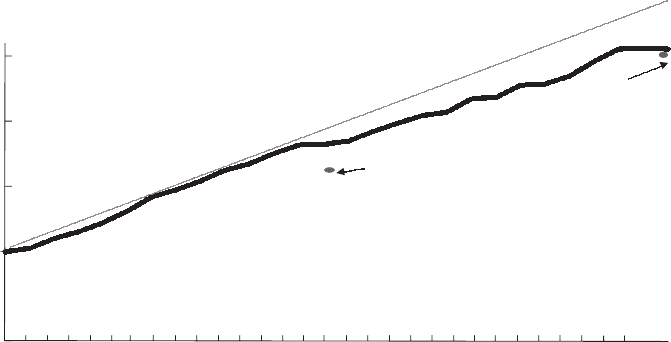Bulmer-Thomas V., Coatsworth J., Cortes-Conde R. The Cambridge Economic History of Latin America: Volume 2, The Long Twentieth Century
Подождите немного. Документ загружается.


Cambridge Histories Online © Cambridge University Press, 2008
P1: GDZ
0521812909c14BCB929-Bulmer 052181290 9 October 6, 2005 14:6
632 Miguel Sz
´
ekely and Andr
´
es Montes
1
1.1
1.2
1.3
1.4
1.5
1.6
1.7
Relative Log Wage
1990 1991 1992 1993 1994 1995 1996 1997 1998
Higher education
relative to primary
Higher education
relative to secondary
Secondary relative
to primary
Figure 14.13.Wage differentials in Latin America in the 1990s.
Source: Jere Behrman, Suzanne Duryea, and Miguel Sz
´
ekely, “Schooling Investments
and Aggregate Conditions: A Household-Survey Approach for Latin America and the
Caribbean.”
differential shows a similar pattern, while the secondary-to-primary gap
increased during the first five years of the decade and decreased during the
second half.
Figure 14.14 summarizes the country-year information for the marginal
return to each level of schooling for the years between 1990 and 1998 (pro-
files normalized to the value of the coefficient for 1990).
29
The generally
positive slope for the linear return reflects the fact that the return to an
extra year of schooling in Latin America has increased by about 7 percent
during the 1990s. The disaggregation by schooling levels reveals that the
increase is totally driven by the large rise in the marginal return to higher
(post-secondary) schooling. The returns to primary and secondary school-
ing declined after the early 1990s, though with partial recovery in the late
1990s.
Table 14.11 provides some evidence on the returns to education by coun-
try.
30
According to the table, having incomplete primary schooling implies,
29
The estimates are the regional average for the returns to schooling from log-wage regressions for each
household survey.
30
The table shows the coefficients of a standard Ordinary Least Squares (OLS) Mincer regression
where the dependent variable is the log hourly wage of each individual and the independent variables
are experience (proxied by age six minus years of schooling), experience squared, and a vector of
dummies representing five different education levels. The returns on education are determined

Cambridge Histories Online © Cambridge University Press, 2008
P1: GDZ
0521812909c14BCB929-Bulmer 052181290 9 October 6, 2005 14:6
Poverty and Inequality 633
0.8
0.9
1
1.1
1.2
Marginal Return to Completing a Cycle
1990 1991 1992 1993 1994 1995 1996 1997 1998
Higher
Primary
Linear return per year
Secondary
Figure 14.14.Marginal returns to education: Latin America in the 1990s.
Source: Jere Behrman, Nancy Birdsall, and Miguel Sz
´
ekely, “Economic Reform and Wage
Differentials in Latin America” (Working Paper, Inter-American Development Bank,
2000).
on average, an income 18 percent higher than that for people with no school-
ing. Complete primary education yields a return of 37 percent, whereas
incomplete and complete secondary education have returns of 61 percent
and 95 percent, respectively. The greatest returns are observed for higher
education, with 152 percent on average. The largest differences in returns
between the lowest and highest schooling levels are observed in Brazil,
Chile, Colombia, and Mexico.
This evidence illustrates the circularity between asset ownership, use,
and return. The poor have the smallest stocks of human capital. In the
case of females, those with fewer assets tend to use them to a lower extent.
Furthermore, those with the smallest stocks of human capital receive the
lowest rewards not only for having a small stock but also because the returns
are nonlinear and increase with the size of the stock. Finally, because of the
low returns, the poor (especially women) ultimately earn lower rates on
their assets.
returns to physical capital
The return on an asset such as physical capital has many components, a fact
that complicates the analysis. This chapter’s treatment of physical capital
byavariety of factors and are less subject to individual preferences and decisions. The regression is
estimated for adults in the 25–65 age range and does not correct for sample selection biases attributable
to participation. However, the conclusions about the changes in the returns to education and the
differences between low and high schooling levels do not change substantially when corrections for
the bias are attempted.

Cambridge Histories Online © Cambridge University Press, 2008
P1: GDZ
0521812909c14BCB929-Bulmer 052181290 9 October 6, 2005 14:6
Table 14.11. Returns to education in Latin America during the 1990s
Coefficients from ordinary least squares (OLS) regression
Primary Primary Secondary Secondary Higher
Country Year incomplete complete incomplete complete education
Argentina
∗
1996 0.12 0.21 0.34 0.61.03
Bolivia
∗
1990 −0.14 −0.06 0.11 0.21 0.49
1991 −0.14 −0.06 0.11 0.21 0.49
1993 0.09 0.17 0.36 0.66 1.11
1995 0.06 0.16 0.25 0.56 1.13
Brazil 1992 0.12 0.26 0.47 0.84 1.54
1993 0.10.24 0.47 0.82 1.5
1995 0.45 0.82 1.17 1.72 2.5
1996 0.41 0.76 1.13 1.65 2.39
Chile 1990 0.19 0.36 0.66 0.97 1.72
1992 0.20.33 0.61 1.02 1.83
1994 0.27 0.44 0.67 1.11 1.87
1996 0.19 0.38 0.67 1.08 1.92
Colombia 1997 0.19 0.55 0.82 1.28 2.1
Costa Rica 1989 0.22 0.42 0.71.04 1.51
1991 0.11 0.27 0.53 0.84 1.47
1993 0.30.43 0.65 0.88 1.55
1995 0.21 0.37 0.57 0.84 1.44
Dom. Rep. 1996 0.30.49 0.63 0.75 1.39
Ecuador 1995 0.23 0.49 0.91.26 1.64
El Salvador 1995 0.26 0.49 0.73 1.17 1.77
Honduras 1992 0.15 0.38 0.71 1.11 1.82
1996 0.24 0.54 0.71.23 1.9
1998 0.17 0.40.59 1.79 1.92
Mexico 1989 0.33 0.68 1.05 1.47 1.9
1992 0.43 0.82 1.27 1.72 2.37
1994 0.24 0.52 0.88 1.39 2.05
1996 0.09 0.40.93 1.65 2.43
Nicaragua 1993 0.40.55 0.71 0.99 1.47
Panama 1991 −0.07 0.04 0.22 0.47 0.96
1995 0.06 0.14 0.33 0.56 1.09
1997 −0.03 −0.06 0 0.23 0.96
Paraguay 1995 0.32 0.71 1.07 1.63 2.26
Peru 1991 0 −0.02 0.08 0.12 0.31
1994 0.03 0.08 0.27 0.34 0.73
1997 0.22 0.29 0.50.56 1.09
Uruguay
∗
1989 0.03 0.12 0.27 0.32 0.52
1992 0.27 0.51 0.81 0.99 1.47
1995 0.18 0.36 0.73 0.93 1.46
Venezuela 1995 0.35 0.55 0.73 0.98 1.44
1997 0.27 0.43 0.58 0.88 1.59
Average LAC 1997 0.18 0.37 0.61 0.95 1.52
∗
Surveys with urban coverage.
Source: Orazio Attanasio and Miguel Sz
´
ekely, eds., Portrait of the Poor (Washington, DC, 2001).
634

Cambridge Histories Online © Cambridge University Press, 2008
P1: GDZ
0521812909c14BCB929-Bulmer 052181290 9 October 6, 2005 14:6
Poverty and Inequality 635
-4
-2
0
2
4
6
8
10
12
1967
1969
1971
1973
1975
1977
1979
1981
1983
1985
1987
1989
1991
1993
1995
1997
Figure 14.15.Real interest rates for five Latin American countries.
Source: World Bank Global Development Finance & World Development Indicators
(Washington, DC, 2002).
has focused more on its investment component than its infrastructure one.
Because there is no single price that can be used to describe the evolution
of the returns to physical capital investment, this subsection concentrates
on the evolution of interest rates as a general price indicating the behavior
of returns to physical capital, specifically investment.
Figure 14.15 shows the average real interest rate for five Latin American
countries (Brazil, Colombia, Chile, Mexico, and Venezuela) for the period
1965–99.
31
As can be seen, with only few exceptions (eight years out of
the thirty-five spanning the 1965–99 period), real interest rates are posi-
tive and high in many cases. Average real interest rates fluctuated around
1 to 2 percent during the 1960s and early 1970s, were generally low during
the late 1970s, and were positive during practically all the following twenty
years, reaching levels above 10 percent during the mid-1990s. Real interest
rates are a lower-bound indicator of the returns to capital in an economy,
31
Because of the high volatility of real interest rates in most countries, we concentrate only on these
five cases. The data correspond to three-year moving averages for each of the five countries (this is
why the figure plots the data from 1967 on).
Cambridge Histories Online © Cambridge University Press, 2008
P1: GDZ
0521812909c14BCB929-Bulmer 052181290 9 October 6, 2005 14:6
636 Miguel Sz
´
ekely and Andr
´
es Montes
so the data reveal that those owning physical capital assets were most likely
obtaining considerable rewards for putting them to work.
Another way of determining whether returns to capital are attractive in
an international context is the flow of foreign investment to a country.
Presumably, if all other factors remain the same, capital will flow to a
country when its returns (e.g., corrected by risk factors) exceed those that
would be obtained elsewhere. Latin America did attract foreign investment
during the 1990s. This is in stark contrast with the previous two decades,
when hardly any flows took place. The levels of FDI during the 1970s and
1980swere very small because the region was largely closed to capital flows,
but the relatively high levels during the 1990s suggest that returns to capital
in the region were, in fact, attractive.
FACTOR ENDOWMENTS AND
INCOME DISTRIBUTION
The evidence presented in the previous three sections suggests that the
factors underlying the historical persistence of inequality and poverty in
Latin America are the following: (1) income-earning assets in the region have
historically been unevenly distributed among the population; (2) those who
have fewer assets also find fewer opportunities to use these assets to generate
income; and (3) asset returns are lower on a per-unit basis for those with
smaller stocks of assets, so that the poor incur a double financial penalty.
These conclusions may come as a surprise to those arguing that trade
liberalization processes – which have been pursued by most of the countries
in the region since the 1980s–tend to raise the demand for unskilled labor
in unskilled labor-abundant countries such as those in Latin America. This
increased demand is expected, in turn, to reduce inequality and poverty by
boosting the wages for workers with lower schooling levels. Similarly, one
would expect that countries in which physical capital is relatively scarce –
again, as in Latin America – would experience positive capital inflows with
trade openness and capital account liberalization, precisely because of the
initially high returns inherent in a closed economy. This would tend to
reduce the returns to capital, which would ultimately improve income
distribution, given that capital is usually concentrated among the rich.
Under the same argument, if a country that is land-abundant relative to
the rest of the world opens up to trade, the returns on this asset will tend
to increase. The effect on income distribution will depend on how stocks
Cambridge Histories Online © Cambridge University Press, 2008
P1: GDZ
0521812909c14BCB929-Bulmer 052181290 9 October 6, 2005 14:6
Poverty and Inequality 637
of land are distributed, so for Latin America this would have been expected
to be inequality-increasing.
Why does an apparent contradiction arise between the expected results
from economic liberalization processes in Latin America, on the one hand,
and the empirical evidence presented in the second section on the other?
Is standard trade theory not useful for understanding the current reality in
Latin America? Or is it that perhaps Latin America is not what it seems?
What if, for instance, the region is not as abundant in unskilled labor
as is widely believed? This section develops the argument that the key to
the apparent paradox might be the following: the theory is valid, but the
perceptions are flawed. What seems to be unfounded are the beliefs that the
region has an advantage in producing unskilled labor-intensive goods at low
cost, that capital is significantly scarcer than in the rest of the world, and that
land is a considerably abundant factor. In fact, this section proposes that
Latin America is caught between two worlds. On the one hand, it is not the
most unskilled labor-abundant region. On the other, however, schooling
progress has been so sluggish in the past few decades that the region has
not effected the “big push” observed in other countries (e.g., East Asia) to
reach the point at which comparative advantages in semiskilled labor were
achieved. In a similar vein, capital is certainly not as abundant as in the
most developed economies but, at the same time, it is not as scarce a factor
as in the average developing country. Furthermore, with technical progress,
land does not appear to be as abundant a factor as is commonly supposed.
The region has arrived at this state because at the time that the region’s
endowments were changing, the world was also evolving. Large countries
such as China and India entered the global markets during the 1980s, caus-
ing sizable shifts in the world effective factor endowments. These countries
have a large abundance of relatively unskilled labor, scarce capital, and rel-
atively abundant land. In bringing these factor endowments to the world
market, they have modified the amount of factors of production that are
available on a global scale and, in open competition for world markets,
this has had enormous effects over the prices paid for human and physical
capital in the international arena.
In order to develop this argument, the calculations and estima-
tions by Spilimbergo, Londo
˜
no, and Sz
´
ekely are updated and presented
subsequently.
32
These authors obtain world average values for factor
32
Antonio Spilimbergo, JuanLuis Londo
˜
no, and Miguel Sz
´
ekely, “Income Distribution, Factor Endow-
ments and Trade Openness,” Journal of Development Economics 59 (1997): 77–101.
Cambridge Histories Online © Cambridge University Press, 2008
P1: GDZ
0521812909c14BCB929-Bulmer 052181290 9 October 6, 2005 14:6
638 Miguel Sz
´
ekely and Andr
´
es Montes
endowments by computing each country’s share in world trade and mul-
tiplying this share by the factor endowment (human capital, physical cap-
ital, and land) to obtain a trade-weighted average.
33
The weights are used
because the factor endowments of a country only compete in the world
market if the country actually trades. Therefore, endowments of countries
totally closed to international trade have no weight in the average, whereas
those that do trade are weighted by their importance in international
markets.
34
trade and human capital endowments
The story of the evolution of human capital is illustrated in Figure 14.16,
which plots the endowment of the most unskilled labor available for pro-
duction – that is, the share of workers with no schooling among the pop-
ulation over twenty-five years of age.
35
As can be seen, Latin America has a
much larger share of working-age population with no schooling than the
East Asian economies or the world average but has a considerably lower
share than South Asia, the most populous region in the world.
33
These authors estimate country and world endowments up to 1992.Here we update the figures to
1996.Weuse the same estimation methods and (updated) data sources as these authors.
34
There are some other studies addressing the trade–inequality relationship. Francois Bourgignon
and C. Morrison, eds., External Trade and Income Distribution (Paris, 1989), develop a model in
which income distribution depends on factor endowments and the degree of trade openness of each
country. By using a cross-country analysis of thirty-six observations in 1970, they conclude that
factor endowments can explain 60 percent of the difference in income shares of the bottom decile
across countries. Sebastian Edwards, “Openness, Trade Liberalization and Growth in Developing
Countries,” Journal of Economic Literature 31 (1997): 1358–93, uses a larger sample of countries with
time-series observations, but does not find any significant effect of trade on income distribution.
There is a larger number of studies addressing the trade–wage inequality relationship. For example,
see Donald Robbins, “HOS Hits Facts: Facts Win: Evidence on Trade and Wages in the Developing
World” (Development Discussion Paper 557,Harvard Institute for International Development,
Harvard University, 1996); Adrian Wood, North-South Trade Employment and Inequality: Changing
Fortunes in a Skill-Driven World, (London, 1994), and “Openness and Wage Inequality in Developing
Countries: The Latin American Challenge to East Asian Conventional Wisdom,” The World Bank
Economic Review (1996); George Borjas and Valerie Ramey, “Foreign Competition, Market Power
and Wage Inequalities,” The Quarterly Journal of Economics XC (1995): 1075–1110; Richard Freeman
and Lawrence Katz, eds., Differences and Changes in Wage Structure (Chicago, 1995). We chose the
methodology by Spilimbergo, Londo
˜
no, and Sz
´
ekely for two reasons. The first is that they use
more adequate trade openness measure and estimation methods, and the second is that rather than
focusing on wage inequality, they consider the distribution of total household income.
35
These figures use the share of adults with no schooling, primary, secondary, and higher education
from the updated Barro-Lee database. See Jong Wha Lee and Robert Barro, “International Data on
Educational Attainment: Updates and Implications,” (Working Paperno.42, Center for International
Development, Harvard University, April 2000)tomeasure the human capital endowment of each
country. East Asia, according to the definition adopted here, comprises the four fastest growing East
Asian countries.

Cambridge Histories Online © Cambridge University Press, 2008
P1: GDZ
0521812909c14BCB929-Bulmer 052181290 9 October 6, 2005 14:6
5
10
15
20
25
30
35
1976 1977 1978 1979 1980 1981 1982
1983 1984 1985 1986 1987 1988
1989 1990 1991 1992 1993 1994 1995
World
Latin Americ
a East
Asia
South Asia
Figure 14.16.P
ercentage of workers with no schooling among the population over tw
enty-five years of age by region.
Source:
Authors’ own calculations.
639
Cambridge Histories Online © Cambridge University Press, 2008
P1: GDZ
0521812909c14BCB929-Bulmer 052181290 9 October 6, 2005 14:6
640 Miguel Sz
´
ekely and Andr
´
es Montes
Where Latin America stands out is in the abundance of workers with pri-
mary schooling. The bulk of the working-age population in Latin America
has only achieved some level of primary education. That is not the case
in South Asia, where primary schooling still seems to be a “luxury good”
for most. It is not the case in East Asia, either, but for the opposite reason
that considerable strides have been made in schooling progress. The share
of population that has either no schooling or only primary in that region
is very low.
On the other hand, Latin America falls far behind East Asia, South
Asia, and the world average with respect to the endowment of work-
ers with secondary schooling. Whereas in South Asia, about 33 percent
of the working-age population has achieved secondary schooling, only
20 percent have done so in Latin America. Because the factor is scarcer
in Latin America, it would be expected that local wages for workers with
secondary school would be relatively high; their wages would be relatively
low in South Asia because of greater abundance. The contrast with East
Asia and the world average is even starker.
Latin America is also not well-endowed with workers with higher edu-
cation. Although it has caught up with the rest of Asia, its endowments are
still well below those in East Asia and the world average. Thus, the returns
to these skills in the labor market would be expected to be relatively high
in the region and, consequently, the global demand for them relatively low.
Figure 14.17 plots the world’s effective endowment of skilled labor from
1965 to 1995.
36
The figure demonstrates that the rate of change of the
world endowment declines between 1960 and 1980. This is because of the
entry of China and India into world markets. Because these two countries
have high numbers of unskilled labor, they drive the world average down.
Given this change, Latin America by 1996 seemed to be a region with
human capital endowments very similar to the world endowment, with no
particular advantage in international markets. At the dawn of the twenty-
first century, Latin America neither belongs to the group of countries in
which unskilled labor is highly abundant, nor does it belong to the group
of countries that have made enough schooling progress so as to have an
abundant semiskilled labor work that can compete and be highly rewarded
in world markets.
36
Following Spilimbergo, Londo
˜
no, and Sz
´
ekely, effective endowments are calculated by obtaining the
weighted average of country endowments, where the weight is given by the participation of the
country in world trade (low weights imply that the country’s endowments compete less in world
markets). These authors’ calculations are extended to include the 1992–6 period.

Cambridge Histories Online © Cambridge University Press, 2008
P1: GDZ
0521812909c14BCB929-Bulmer 052181290 9 October 6, 2005 14:6
Poverty and Inequality 641
50
100
150
200
250
1965
687012 579247990
2
Year
35
LAC, 1980
LAC, 1996Skilled labor
World Endowment
79 34
6
8801 3
5
68 1
4
Figure 14.17.Effective world skilled labor endowments.
Sources: Data for 1965–92 are reproduced from Antonio Spilimbergo, Juan Luis Londo
˜
no,
and Miguel Sz
´
ekely, “Income Distribution, Factor Endowments and Trade Openness,”
Journal of Development Economics 59 (1997): 77–101; 1992–7 data are authors’ calculations
using the same methodology and updated data sources.
In the 1980s, the endowment of unskilled labor in Latin America was
higher than the world average (there was relative scarcity of skilled labor),
which suggests that had the region been open to international trade during
the previous decades, it would have been able to exploit its comparative
advantage in goods produced with relative intensity of unskilled labor. Pre-
sumably, this would have reduced the wage gap between the skilled and
unskilled in the region, and could have resulted in inequality and poverty
reductions. As shown in the second section, the evidence indicates that the
opposite happened in reality because the 1980swere years of significant
increases in inequality. Thus, it seems that the region had the right endow-
ments but the wrong policies at that time. Paradoxically, it is the opposite:
the region had the right policies in terms of benefiting from comparative
advantage, but it had the “wrong” human capital endowments.
trade and endowments of physical capital and land
A similar story applies to the case of physical capital, represented here
by the endowment of capital per worker in each country. Figure 14.18
